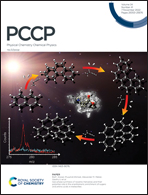Short-range ENDOR distance measurements between Gd(iii) and trifluoromethyl labels in proteins†
Abstract
The measurement of distances in proteins can be challenging in the 5–20 Å range, which is outside those accessible through conventional NMR and EPR methods. Recently it was demonstrated that distances in this range could be measured between a nitroxide as a paramagnetic spin label and a nearby fluorine atom (19F) as a nuclear spin label using high-field (W-band/3.4 T) ENDOR spectroscopy. Here we show that such measurements can also be performed using a gadolinium ion (Gd3+) as the paramagnetic tag. Gd3+ has two advantages. (i) A greater electronic spin (S = 7/2) and fast electronic spin-lattice (T1) relaxation, improving sensitivity by allowing data to be collected at lower temperatures. (ii) A narrow EPR signal for the −½ ↔ ½ transition, and therefore no orientation selection artefacts. Signal intensities can be further enhanced by using a trifluoromethyl (C19F3) group instead of a single 19F atom. Using the protein calbindin D9k with a Ca2+ ion replaced by a Gd3+ ion and a trifluoromethylphenylalanine in position 50, we show that distances up to about 10 Å can be readily measured. Longer distances proved more difficult to measure due to variable electronic TM relaxation rates, which lead to broader Lorentzian ENDOR lineshapes. Gd3+ complexes (Gd3+ tags), which reliably display longer TM times, allow longer distances to be measured (8–16 Å). We also provide preliminary evidence that the intensity of ENDOR signals follows the predicted 1/r6 dependence, indicating that distances r > 20 Å can be measured by this method.



 Please wait while we load your content...
Please wait while we load your content...